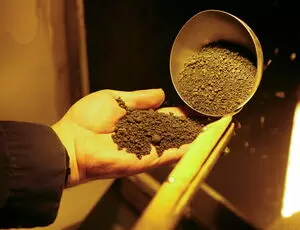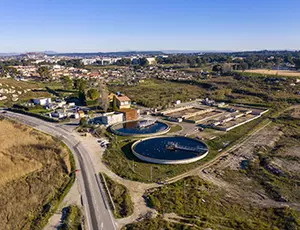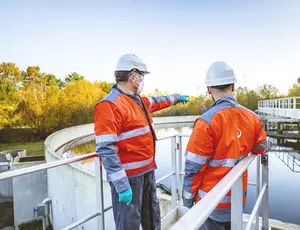Pyrofluid™ is a fluidized-bed incineration technology that uses thermal oxidation to remove organic matter and other residues from dewatered municipal and industrial sewage sludge.
Overview
Water treatment legislation is becoming more and more stringent, increasing overall sludge production — a fact that encourages wastewater treatment plant designers to consider processes that not only eliminate the nuisance caused by sewage sludge but also recover energy and/or recycle the by-products of the treatment.
And this is exactly what we offer with Pyrofluid. Complying with the most strict emission standards, Pyrofluid is especially well suited for sludge incineration because it helps to ensure good dispersion of the solids, good solid-gas contact and a uniform temperature.
The fluidized-bed technology ensures a complete combustion with low excess of combustion air and the thermal energy it produces offers the advantage of being suitable for many purposes such as heating buildings or delivering electrical power through steam generation.
Depending on the characteristics of the ash produced by Pyrofluid, it can be recycled and then used to replace noble materials such as cement or natural materials such as kaolin in cement works, prefabricated concrete, or to stabilize landfill waste.
How Pyrofluid works
Once dewatered, the sewage sludge is fed into the fluidized-bed furnace in several points with a pump. The furnace consists of a layer of hot sand which is fluidized by the combustion air.
The sludge is sprayed directly onto the hot sand. The incineration is mainly carried out in the layer of sand at a temperature around 750° celsius before continuing on in the freeboard area, where the temperature increases up to 850 to 880° celsius.
After cooling, the flue gas is treated and cleaned with an electrostatic precipitator or a bag filter that removes more than 99% of the ash in order to comply with the present gas emission regulation IED 2010/75/EU and the BAT Conclusions 12/11/2019 in Europe, the United States Environmental Protection Agency (USEPA) in North America or local regulation in other areas of the world on waste incineration. Sodium bicarbonate and activated carbon are used to remove the acidic compounds and the heavy metals. Finally, the cleaned flue gas is emitted through the stack.

Feature and benefits
Efficient, reliable, and comprehensive sludge treatment solution with simplified operations and reduced environmental impact
- 24/7 operation for maximum efficiency.
- Easy, automated operation.
- Long-term reliability: excellent resistance to high temperature, erosion and corrosion.
- Total destruction of pathogens.
- Total mineralization of sludge.
- Produce stable and recyclable by-products (ash*, dust.
- No odor.
- Low maintenance costs.
*The ash produced constitutes around 10% of the dewatered sludge amount
Applications
Services
Product range and Resources
To best meet your needs, the Pyrofluid range includes 8 standard models with capacities ranging from 350 to 2,500 kg per hour of volatile matters: R28, R36, R43, R50, R56, R62, R67, R72.
Contact
Veolia Water Technologies has been offering complete sludge incineration plants since the 1970s, with Pyrofluid technology at their heart. These facilities have evolved to provide ever-higher levels of treatment quality, particularly in terms of gas emissions, and to enable ever-greater energy recovery. Our facilities now offer highly efficient environmentally friendly sludge treatment along with the possibility of producing heat or electricity (for use in a district heating network, for example).

Fanny Schwager
Incineration Process Manager, Engineering Department - Veolia Water Technologies
FAQ about Pyrofluid™
What is sewage sludge?
Sewage sludge is the semi-liquid by-product resulting from industrial or municipal wastewater treatment (human domestic waste and industrial waste). Due to the human domestic and industrial waste contained in wastewater, sewage sludge is a mixture of organic matter and valuable nutrients (such as nitrogen and phosphorus) that can be recycled and reused as soil fertilizer but can also contain pollutants such as heavy metals, chemicals, viruses, drug residues, radioactive material, etc. Therefore, it is important to treat them in order to prevent environmental pollution, unpleasant odors in residential areas, and health hazards.
What is a fluidized bed incinerator?
A fluidized bed incinerator is set with a bed of hot sand or other granular material to transfer heat directly to waste. It is especially useful for the removal of industrial and municipal dewatered sewage sludge.
Why is dewatering sludge important?
Dewatering sludge consists in removing most of the water from sludge by a centrifuge or a filter. It is important to achieve good sludge dryness during the dewatering stage, in order to reach auto-thermal operation. If dewatering is not effective enough to achieve good dryness, it may be necessary to add a pre-drying stage.
Is it possible to recover energy from sludge incineration?
Yes, Veolia Water Technologies has references of steam turbines on its sludge treatment plants, and of providing heat for a digestion unit in the plant (Warsaw in Poland, Saragozza in Spain, St Petersburg in Russia, Noisy-le-Grand in France, etc.).
Is it possible to recycle ashes?
Yes it’s possible to recycle ashes, for example in road building.
Is it possible to recover phosphorus from ashes?
Yes, technologies do exist. In Germany, they will soon be mandatory.






